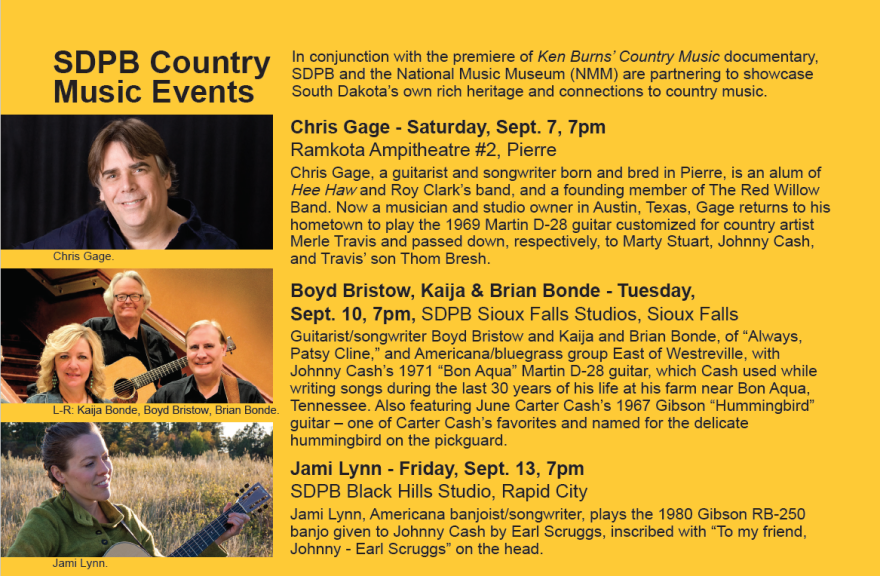When Johnny Cash and his wife June Carter Cash came off concert tours, they retreated to their ranch near Bon Aqua, Tennessee. Cash considered the 107 acres located 40 miles west of Nashville a sanctuary. He wrote in Cash: The Autobiography, “This is a great place for pottering. I can cook my own food, read my own books, tend my own garden, wander my own land. I can think, write, compose, study, rest and reflect in peace.” The Cashes lived in a log home on the Bon Aqua property from 1972 until their deaths, just four months apart, in 2003.
During the last 30 years of his life, Cash wrote songs on a 1971 Martin D-28. Dubbed “the Bon Aqua” for its homeplace, Cash’s rosewood, dreadnought (a borrowed nautical term for “battleship,” in reference to its large size) guitar was sold at an estate sale in 2004. The buyer was André Larson, who since 1972 had been the founding director of the National Music Museum in Vermillion. With plans to open a guitar exhibit, Larson acquired the Bon Aqua along with June Carter Cash’s 1967 Hummingbird model Gibson. June’s favorite for playing and touring, the guitar is named for its etched, hand-painted pickguard, on which a hummingbird in flight sips nectar from a trumpet vine.
Suitably, Johnny and June’s guitars are displayed together in the museum. Or were, until the museum closed this spring to renovate and expand. Until the museum reopens, projected for 2021, the Bon Aqua and the Hummingbird, along with the majority of the items in the museum’s 15,000+ collection, are slated to remain in storage or on loan to other institutions.
But this September, the public has a rare opportunity to not only see but hear Johnny and June’s guitars, as well as the banjo given to Cash by bluegrass legend Earl Scruggs and the 1969 Martin D-28 passed down, respectively, from Merle Travis, Marty Stuart, Johnny Cash and Travis’ son Thom Bresh.
South Dakota musicians, including Chris Gage, Boyd Bristow, Kaija and Brian Bonde, and Jami Lynn will perform on the historic instruments at free, live concerts in Pierre, Sioux Falls and Rapid City. (For details, see p.18.)
The balance between preserving and playing historic instruments is delicate. “We choose the instruments we play extremely carefully to minimize putting them at risk,” says Arian Sheets, who since 2001 has curated stringed instruments for the museum, including the world’s oldest cello, an Andrea Amati “King” Cello from 1550. “For a Johnny Cash fan, hearing an instrument Cash played intimately in his home is a meaningful, evocative experience. We don’t want to abuse the opportunity, but we don’t want to be an institution where we imprison things. We hold these objects in the public trust and we are here for our public.”
The last time the 1969 Travis/Stuart/Cash/Bresh Martin D-28 was heard was 14 years ago, when Bresh, a finger picker in his father’s “Travis style,” played at the museum’s guitar gallery opening. As a young man, Bresh was given the guitar by Cash, who urged him to play it, advising: “You’ll be able to say this guitar was owned by three great musicians and a poet.” Instruments often made the rounds, says Sheets, as musicians of this era traded and collected instruments by players they admired. “They were also fans of country music and they really, deeply admired and respected their colleagues just as much as a fan would.” Chris Gage, a founding member of Red Willow and an alum of Hee Haw and Roy Clark’s band, returns to his hometown of Pierre September 7 to share the sound of the oft-gifted Martin with the public. “I’m honored to be asked and excited to be a part of this,” said Gage. “Pierre is still in my blood, of course.”
While Sheets says many of the museum’s professional-grade guitars were built for use and don’t require significant curatorial intervention, circumstances simply render some instruments more fragile. The 1980 banjo Scruggs gave Cash, for example, has never been played or exhibited since it came to the museum in 2004. Scruggs scrawled “To my friend, Johnny,” on the banjo’s head, using an ink pen. “Scruggs’ signature is fading,” says Sheets. “It won’t hold up in light. If we want to keep his signature, we can’t put the banjo out long-term. Jami Lynn’s performance truly is a special opportunity to see and hear that instrument.”
Understandably, the historic instruments require some extra TLC. On display, the rosewood and plastic instruments are kept in 70 degrees with 50% humidity and relatively low light levels. In storage, the instruments are kept in their cases, wrapped in TyVek, the same polyethylene fiber used to protect houses under construction. The instruments are kept at minimal tension to thwart warping of the neck and bridge. In transit, curators carefully roll the cases on a cushioned cart, its sides padded with customized pool noodles.
For the performances, Sheets will debrief the musicians about special handling and admits to a level of nervousness when she tunes or plays the irreplaceable items herself. “I’ll leave the tuning to the musicians,” she laughs. “A generally careful performer would treat their own instruments how we ask them to treat these – handle it by the neck and end, try to stay seated while holding it. But I take it very seriously because, owning it in the public trust, we don’t want to damage something that belongs to everybody. We want someone 100 years from now to be able to hear a Johnny Cash guitar.


